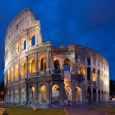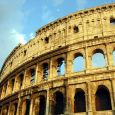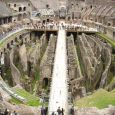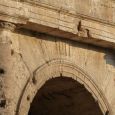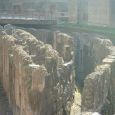Colosseum
Advertisement
By Air
Leonardo da Vinci International Airport (Rome Fiumicino, IATA: FCO, tel.: 65631) - Rome's main airport is modern, large, rather efficient, and well connected to the center of the city by public transportation. However, late-night arrivals may limit you to an irregular bus into town unless you can afford a taxi.
By Train
Rome's main railway station is Termini Station which is locked between 00:30 and 04:30. Most long-distance trains passing through Rome between these times will stop at Tiburtina station instead.Other main stations include Ostiense, Trastevere, Tuscolana, Tiburtina.
By Boat
Most cruise ships dock in Civitavecchia, to afford their passengers opportunity to visit the area and/or Rome. Many ships arrange a shuttle bus to and from the port entrance. From there you can walk 10-15 minutes along the shore to the Civitavecchia train station. Purchase of a B.I.R.G. round trip train ticket and also entitles you to unlimited use of Rome's Metro/underground and city bus lines. Trains for commuters leave every hour or so, more often during rush hours, and take about 80 minutes. You can get off near St. Peters, or continue to the Termini station right downtown, where countless buses and the Metro await. At some ten times the cost, cruise ships often offer bus transport as well, taking 2 hours or so to reach Rome depending on traffic.It is now possible for modest-sized cruise ships to dock in the new Porto di Roma, Ostia, located 20 kilometers from Rome and linked by train and metro. Stations are not within practical walking distance from the pier.
By Car
Driving to Rome is quite easy; as they say, all roads lead to Rome. The city is ringed by a motorway, the Grande Raccordo Anulare or GRA. If you are going to the very centre of the city any road leading off the GRA will get you there. If you are going anywhere else, however, a GPS or a good map is essential. Signs on the GRA indicate the name of the road leading to the centre (e.g. Via Appia Nuova, Via Aurelia, Via Tiburtina) but this is useful only for Romans who know where these roads pass.
Seven Hills of Rome
Seven Hills of Rome can be rather difficult to identify. In the first place generations of buildings constructed on top of each other and the construction of tall buildings in the valleys have tended to make the hills less pronounced than they originally were. Secondly, there are clearly more than seven hills. In Roman days many of these were outside the city boundaries.
Trevi Fountain
Trevi Fountain is completed in 1762 to a design by Nicola Salvi, this spectacular Baroque fountain features a mythological sculptural composition of Neptune, god of the sea, flanked by two Tritons: one Triton labours to control a violent sea-horse, the other controls a pacified creature, both symbolising the dual nature of the world's oceans. The location of the Trevi fountain marks the terminus of the ancient Aqua Virgo aqueduct, completed in 19 BCE in order to supply the Baths of Agrippa, and is so named on account of its position at the junction of three roads (tre vie). The fountain appeared in an unforgettable scene of Fellini's film Dolce Vita. The legend says that one who throws a coin in the fountain shall one day return to Rome. The coins in the fountain are regularly collected to finance charities. The fountain has been made even more famous as the target for the Three Coins in the Fountain, soaking the actress Anita Ekberg in Federico Fellini's film La Dolce Vita. According to popular superstition and custom, throwing coins with one's right hand over one's left shoulder into the Trevi Fountain is a practice endowed with good luck. Throwing one coin ensures that the thrower will return to Rome; throwing two coins will ensure that the thrower will fall in love with a beautiful Roman girl (or handsome boy); throwing three coins, finally, ensures that the thrower will marry that girl or boy in Rome itself.
Palazzo Massimo
Palazzo Massimo a magnificent collection of ancient Roman sculptures, mosaics and wall paintings, including the famous paintings from the Imperial-era villa discovered under the Villa Farnesina, as well as the dining room from the Empress Livia's villa at Prima Porta. Located across the piazza from Termini, opposite the Baths of Diocletian.
Quirinal Palace
Quirinal Palace is home of the President of the Italian Republic, and the Quirinal Gardens. Built in 1573 as a papal summer residence, and has since also served as the residence for the pope and later for the king of Italy. The public are occasionally allowed in to view the gardens, but be prepared for a long queue.
Information not available


